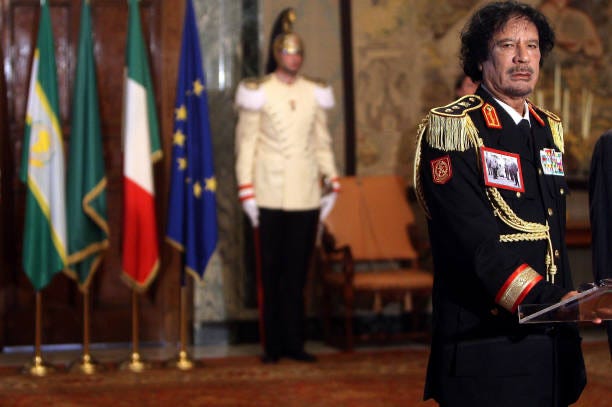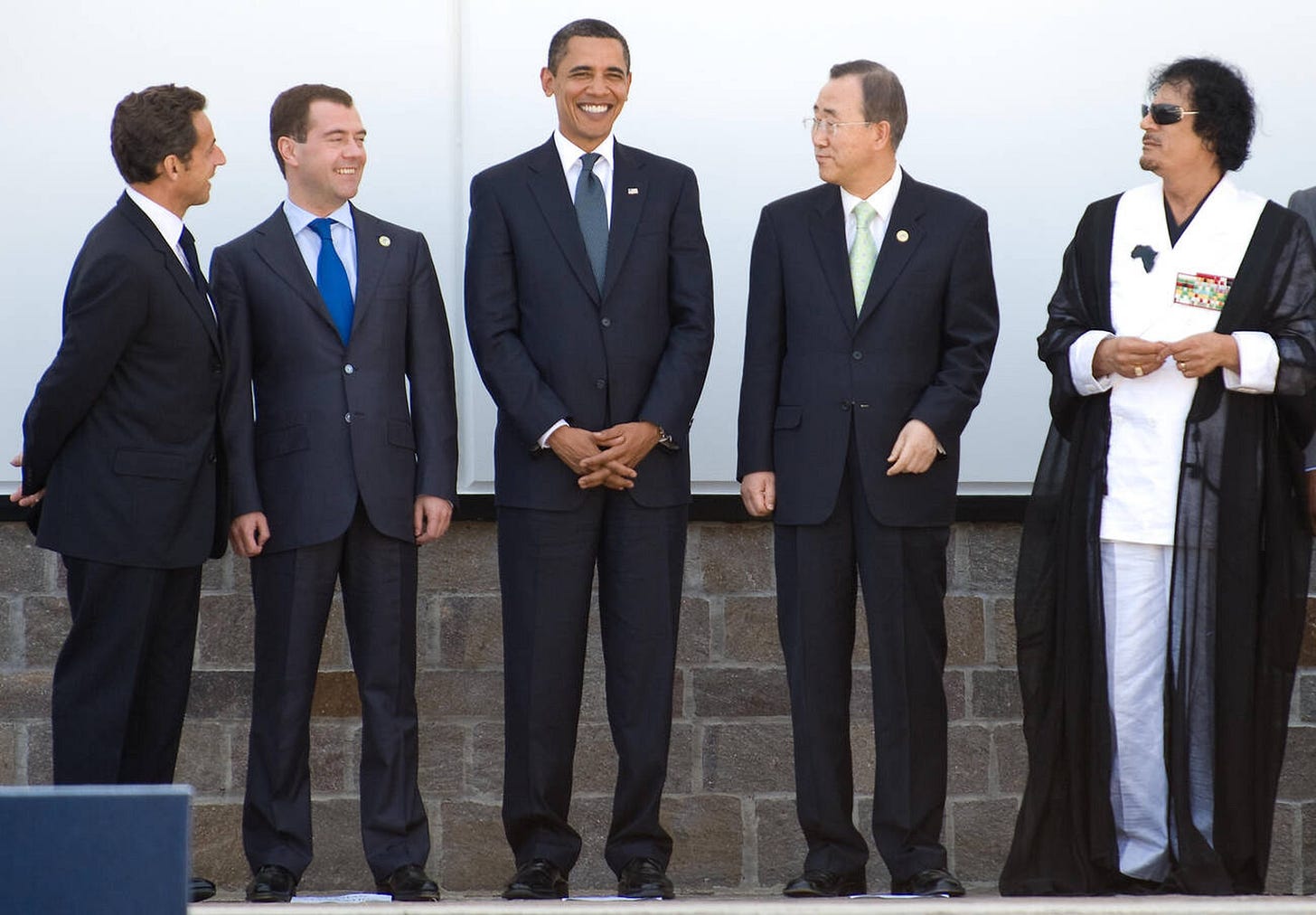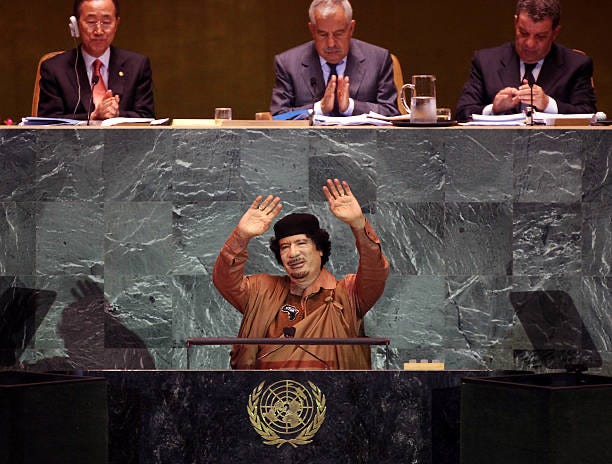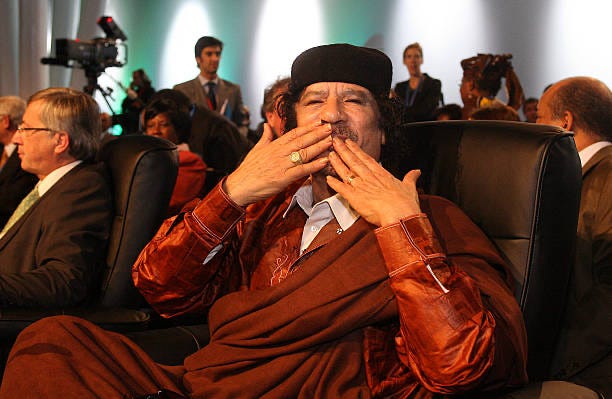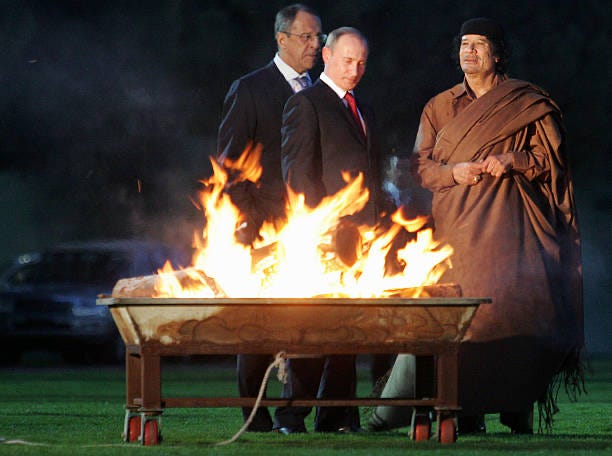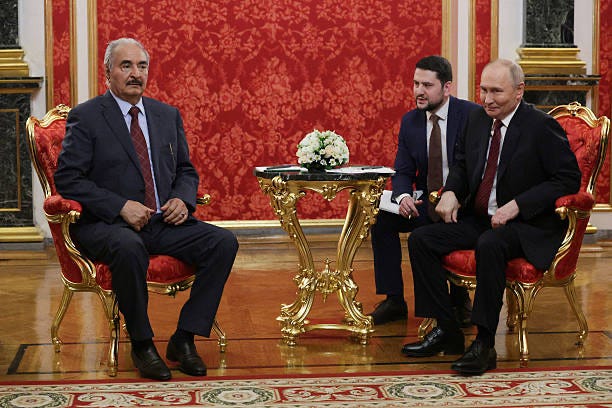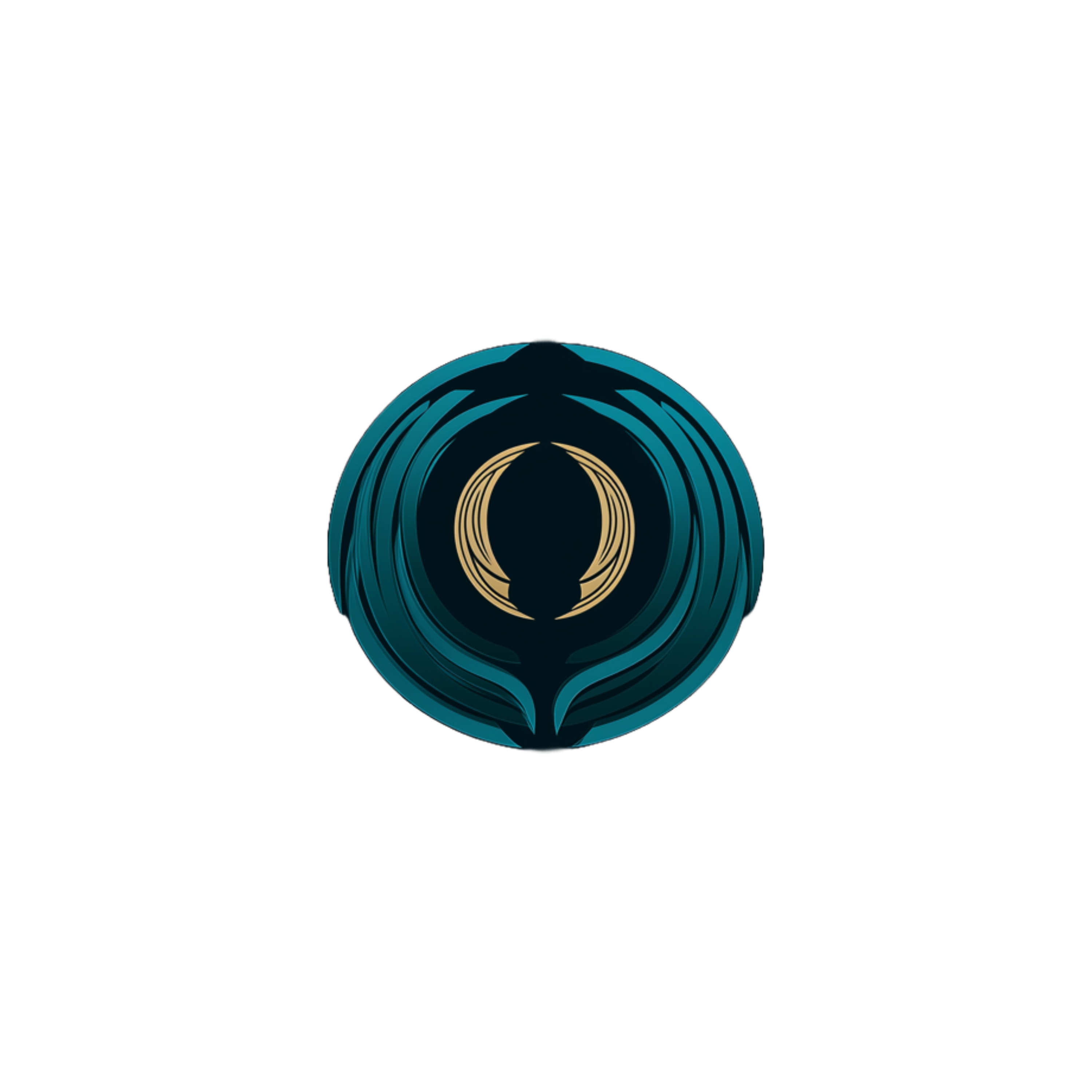A Mediterranean Power with 1700 Kilometers of Coastline
Libya is not merely a desert country with oil reserves, it is a strategic giant that occupies the central spine of North Africa. With a coastline stretching over 1700 kilometers along the southern edge of the Mediterranean, Libya directly faces Europe, positioning itself as both a gatekeeper and a threat. This coastline is longer than those of Egypt, Tunisia, and Algeria combined, making Libya not just a North African country, but a crucial southern flank of Europe. Trade routes, energy corridors, migration flows, and military logistics, everything passes through this space. And at the heart of this space stood one man: Muammar al-Gaddafi.
Libya borders six countries and is a natural transit hub linking Sub-Saharan Africa with Europe and the Middle East. Any state with influence over Libya can project power across the Sahel, threaten European security, and influence global energy markets. And Gaddafi understood this better than anyone.
He used this geography to position Libya not just as a state, but as a pivot. Under his leadership, Libya held the potential to become a major geopolitical player, balancing between Africa, the Arab world, and Europe. And this made him dangerous.
The Unapologetic Arab Leader: Gaddafi’s Persona as Political Defiance
Gaddafi’s wardrobe was never just clothing. It was a political statement. He appeared in pan-African robes, Arab revolutionary uniforms, and Libyan tribal dress with equal command. His image was part of the message: Libya would not be defined by colonial lines. His clothing alone challenged Western narratives. When Condoleezza Rice visited him, he declined to shake her hand, signaling more than cultural etiquette, it was geopolitical posturing. When Tony Blair visited, Gaddafi sat with his legs crossed, deliberately unphased, unmoved by the pomp of Western diplomacy. When he arrived in Rome for G8, he brazenly wore a picture of a legendary Libyan resistance hero Omar Al-Mukhtar in chains alongside his Italian fascist colonizers and hanged in 1931.
This was the essence of Gaddafi: a theatrical, self-styled “King of Kings of Africa,” “Dean of Arab Rulers,” and “Imam of Muslims,” whose titles were both mockery and provocation. But behind the style was substance. Gaddafi’s Libya was no puppet regime. It was a sovereign platform threatening Western hegemony, particularly in Africa.
The West’s War on Libyan Sovereignty: The 1980s to 2011
Western aggression against Libya didn’t begin in 2011. In 1986, the United States bombed Tripoli and Benghazi, targeting Gaddafi directly. That same year, American jets engaged in dogfights over the Gulf of Sirte having Gaddafi draw “The Line of death” and a F-14 was destroyed. Washington framed Libya as a rogue state, but the truth was more complex. Libya was resisting the encroachment of American and French influence in Africa. The conflict in Chad sparked by colonial border disputes became another proxy war. Libya intervened, seeking to redefine African borders and remove French control. The result: a long, bloody confrontation with deep geopolitical motives.
The Arab Dream: Gaddafi’s Revolutionary Pan-Arabism and Its Collapse
Before Muammar Gaddafi turned southward to Africa, he looked east—toward Cairo, Damascus, Baghdad. He was a child of the Arab world’s revolutionary moment, raised in the ideological furnace lit by Gamal Abdel Nasser. Pan-Arabism was not a policy for Gaddafi; it was a destiny. He did not merely adopt Nasserism, he inherited it, internalized it, and projected it further than most dared.
From the moment he seized power in 1969, Gaddafi made Arab unity the cornerstone of his political project. He dismantled Western military bases, nationalized oil, and declared Libya’s wealth as belonging not just to Libyans, but to all Arabs. He poured funds into Palestine, into pan-Arab media, into ideological training camps. His message was simple: the Arab world could only rise if it stood together, free from foreign occupation, monarchic regression, and Zionist fragmentation.
He tried unity agreements with Egypt, with Syria, with Sudan, Tunisia, even Morocco. All failed. Each time, Gaddafi was met with either betrayal or hesitation. Arab regimes, bound by dynastic insecurity and foreign dependency, recoiled from unity whenever it came too close. The dream of a single Arab nation was replaced by summits, slogans, and silence.
But Gaddafi never let go of the idea. He carried the Palestinian flag higher than most Arab leaders, insisting that Palestine was not a cause, it was the cause. He offered weapons, training, and direct financial support to various Palestinian factions, seeing the fight against Zionism not as an act of charity but as a responsibility of Arab dignity. While others normalized, he radicalized. While others whispered, he roared.
Gaddafi also tried to revive Arab strategic independence through economic and military means. He envisioned an Arab gold dinar to trade oil outside the dollar. He spoke of an Arab satellite system to rival Western surveillance. He proposed a joint Arab army. None materialized. The Arab world had become too fragmented, too fearful, too dependent.
And so, disillusioned by Arab paralysis and surrounded by regional hypocrisy, Gaddafi turned toward Africa, not to abandon the Arab cause, but to preserve its spirit in a new terrain. His Pan-Africanism was, in many ways, a continuation of his Pan-Arabism founded on sovereignty, dignity, and anti-imperial resistance.
Yet the failure of Pan-Arabism remained the deepest wound. It symbolized the collapse of the Arab world’s post-colonial momentum. And it revealed the true geopolitical order, one in which Arab unity was not just discouraged, but systematically dismantled.
Europe’s Quiet Dependency and Fear of Libya
Few talk about it, but Europe feared Gaddafi and courted him at the same time. Italy relied on him to stem the flow of migrants. Sarkozy of France allegedly received funding from him during his 2007 presidential campaign. European leaders lined up to secure oil deals, weapons sales, and infrastructure contracts. They smiled at Gaddafi, but feared the potential of a Libya that could act independently, resist the IMF, and mobilize African unity.
And Gaddafi used this fear. He controlled migration flows into Europe like a tap. One threat to open the borders was enough to send EU diplomats into crisis mode. Libya was not just a border, it was leverage.
The African Gambit: Gaddafi’s Strategic Vision for a Continent Unchained
Muammar Gaddafi did not only dream of a united Arab world. He carried with him a broader, more daring vision, one that extended deep into the African continent. While Arab unity remained elusive, often sabotaged by rival regimes, foreign interference, and internal betrayals, Gaddafi turned southward. There, in the heart of Africa, he saw both a vacuum of leadership and a reservoir of untapped strength.
He spoke not of charity, but of liberation. He did not imagine Africa as a dependent continent to be pitied, but as a sleeping power to be organized. To him, the future of global power was not just in oil reserves or military arsenals, it was in population, in culture, and in the ability of nations to speak as one. That is why he poured Libya’s oil wealth into pan-African institutions. He funded the African Union, pushed for a single African currency backed by gold, and proposed the creation of an African central bank. He envisioned a unified African military force, an African NATO that would defend sovereignty, not compromise it.
These were not utopian ideas. They were political time bombs, especially for the West. A continent no longer reliant on the IMF or the World Bank, a continent not using the CFA franc or the dollar, was a nightmare for the guardians of global financial hegemony. A “United States of Africa” under Gaddafi’s spiritual guidance would have tilted the global order, placing Africa as a negotiating bloc not a begging bowl in global affairs.
It is no surprise, then, that many African leaders referred to him as the “King of Kings.” Gaddafi dressed the part too adorned in both Arab robes and African gold-stitched attire, his garments became an extension of his politics. His symbolic gestures were more than theatre. They were statements of defiance in a world that demanded submission.
He poured billions into infrastructure projects, telecom networks, and universities across sub-Saharan Africa. His influence stretched from Mali to Niger, from Chad to South Africa. And while some accused him of patronage, others knew the deeper story: Gaddafi was building a continental legacy, one that sought to bypass the gatekeepers of the old world.
Yet this vision came at a cost. France, in particular, saw Gaddafi’s growing influence in its former colonies as a threat to its post-colonial empire. The incursion into Chad, the complex proxy battles in the Sahel, and the creation of African intelligence alliances independent of Paris, all of these sounded alarms in the Elysee Palace. NATO’s decision to destroy Libya in 2011 must be read not merely as a humanitarian intervention, but as a geopolitical correction, a preemptive strike against African sovereignty rising too fast and under the wrong flag.
And so, Gaddafi’s African dream became another nail in the coffin. A dream too ambitious for a world built on division. A threat too dangerous for those invested in Africa’s weakness.
2011: The Return of the Colonial Mindset
The Arab Spring offered a convenient moment for Western capitals. Under the pretext of protecting civilians, NATO launched an extensive bombing campaign in 2011, targeting Libyan infrastructure, air defenses, and Gaddafi himself. The aim was regime change, but the motive was deeper: to prevent Libya from rising as an independent geopolitical actor. Western think tanks understood the threat Libya posed, not in military terms, but in ideological and strategic ones. Gaddafi’s Libya was building alliances across Africa, questioning financial orthodoxies, and maintaining strategic depth in the Mediterranean.
It was no accident that the Arab Spring toppled the region’s most independent regimes. Tunisia, Egypt, Libya, Syria, and Yemen, all these states, though flawed, represented national projects with local sovereignty. Libya was the jewel in this campaign. By 2011, its GDP per capita rivaled that of Eastern European states. Education, health care, and housing were guaranteed. Libya had no foreign debt and had begun African investment projects that bypassed Western banks.
Libya in a Multipolar World: A Threat to the Unipolar Order
In today’s emerging multipolar world, Libya’s natural place would have been among the non-aligned, sovereign powers. Its oil wealth, vast desert geography, and ideological independence made it a prime candidate for an African-Arab coalition against Western dominance. Had Libya continued its post-2003 normalization path reopening to global markets while maintaining autonomy, it could have been a powerful counterweight in the Mediterranean. Gaddafi envisioned this, navigating between Moscow, Beijing, and the West, but never surrendering to any.
That was the danger: a Libya outside the Western fold, aligned with rising powers, and inspiring other Arab and African states to resist.
The Libyan Puzzle Today: Between Sovereignty and Fragmentation
Marshal Khalifa Hafter, member of the Free Officers Movement, a main participant of 1969 Al Fatah Revolution and colleague of Gaddafi, facing a fractured state controlling most of the country’s territory, while rival administrations remain in Tripoli and other western enclaves. Haftar enjoys regional support, particularly from Egypt and the UAE, and has cultivated relations with Russia. His popularity is rising, especially in eastern Libya. But the country remains divided, its institutions weak, and its sovereignty compromised.
So the question remains: what is the fate of Libya? Will it re-emerge as a sovereign Arab-African power, or remain a buffer zone managed by foreign actors? Will it reclaim Gaddafi’s vision, or be reduced to tribal fiefdoms and proxy wars?
One thing is clear: Libya is too important to ignore, too dangerous to leave alone, and too rich to be left to its people. That is why the world toppled Gaddafi, and why his ghost still haunts the corridors of Western power.
